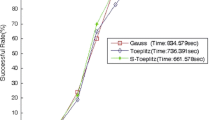Abstract
The measurement matrices play a crucial role in compressed sensing, directly impacting the performance of signal sampling and reconstruction. As one of the primary construction methods for measurement matrices, designing structured measurement matrices is a challenging problem. In practical sampling, the measurement matrices often have strong coherence. Therefore, it is significant to design structured measurement matrices with superior reconstruction performance at low sampling, although the coherence is strong. In this paper, by introducing a special Gram matrix and merging it with the deterministic Fourier matrix, we construct a kind of measurement matrices with superior signal recovery performance under strong coherence. Furthermore, utilizing Katz’ character sum estimation allows us to establish an upper bound on the coherence of the constructed matrices. All experimental results demonstrate that the performance of the proposed matrices outperform that of Fourier matrices and Gaussian random matrices. Consequently, the proposed matrices hold significant application in sparse signal processing.




Similar content being viewed by others
References
R. Adamczak, A tail inequality for suprema of unbounded empirical processes with applications to Markov chains. Electron. J. Probab. 13(34), 1000–1034 (2008)
A. Amini, F. Marvasti, Deterministic construction of binary, bipolar, and ternary compressed sensing matrices. IEEE Trans. Inf. Theory 57(4), 2360–2370 (2011)
W.U. Bajwa, J.D. Haupt, G.M. Raz, S.J. Wright, R.D. Nowak, Toeplitz-structured compressed sensing matrices, in 2007 IEEE/SP 14th Workshop on Statistical Signal Processing (Madison, 2007), pp. 294–298
R. Baraniuk, M. Davenport, R. DeVore, M. Wakin, A simple proof of the restricted isometry property for random matrices. Constr. Approx. 28, 253–263 (2008)
E.J. Candès, J. Romberg, T. Tao, Robust uncertainty principles: exact signal reconstruction from highly incomplete frequency information. IEEE Trans. Inf. Theory 52(2), 489–509 (2006)
E.J. Candès, T. Tao, Near-optimal signal recovery from random projections: Universal encoding strategies? IEEE Trans. Inf. Theory 52(12), 5406–5425 (2006)
S. Das, J.K. Mandal, A modified column block toeplitz matrix for compressed sensing. Signal Image Video Process. 17(6), 3083–3090 (2023)
G. Davis, S. Mallat, M. Avellaneda, Adaptive greedy approximations. Constr. Approx. 13, 57–98 (1997)
R.A. DeVore, Deterministic constructions of compressed sensing matrices. J. Complexity 23(4–6), 918–925 (2007)
T.T. Do, T.D. Tran, L. Gan, Fast compressive sampling with structurally random matrices, in IEEE International Conference on Acoustics. Speech and Signal Processing (Las Vegas, 2008), pp. 3369–3372
D.L. Donoho, X. Huo, Uncertainty principles and ideal atomic decomposition. IEEE Trans. Inf. Theory 47(7), 2845–2862 (2001)
D.L. Donoho, Compressed sensing. IEEE Trans. Inf. Theory 52(4), 1289–1306 (2006)
A. Eftekhari, H.L. Yap, C.J. Rozell, M.B. Wakin, The restricted isometry property for random block diagonal matrices. Appl. Comput. Harmon. Anal. 38(1), 1–31 (2015)
M. Elad, Sparse and Redundant Representations: From Theory to Applications in Signal and Image Processing (Springer, New York, 2010)
S. Foucart, H. Rauhut, A Mathematical Introduction to Compressive Sensing (Springer, New York, 2013)
A.C. Gilbert, S. Guha, P. Indyk, S. Muthukrishnan, M. Strauss, Near-optimal sparse Fourier representations via sampling, in Proceedings of the Thiry-fourth Annual ACM Symposium on Theory of Computing (Association for Computing Machinery, New York, 2002), pp. 152–161
J. Haupt, L. Applebaum, R. Nowak, On the restricted isometry of deterministically subsampled Fourier matrices, in Annu. Conf. Inf. Sci. Syst., CISS, (Princeton, 2010), pp. 1–6
N.M. Katz, An estimate for character sums. J. Am. Math. Soc. 2(2), 197–200 (1989)
S. Kunis, H. Rauhut, Random sampling of sparse trigonometric polynomials, ii. orthogonal matching pursuit versus basis pursuit. Found. Comut. Math. 8, 737–763 (2008)
S. Li, F. Gao, G. Ge, S. Zhang, Deterministic construction of compressed sensing matrices via algebraic curves. IEEE Trans. Inf. Theory 58(8), 5035–5041 (2012)
J.W. Ma, J. Xu, Y.Q. Bao, S.W. Yu, Compressive sensing and its application: from sparse to low-rank regularized optimization. Signal Process. 28(5), 609–623 (2012)
Y.V. Parkale, S.L. Nalbalwar, Application of compressed sensing for image compression based on optimized Toeplitz sensing matrices. EURASIP J. Adv. Signal Process. 2021, 1–30 (2021)
F. Santosa, W.W. Symes, Linear inversion of band-limited reflection seismograms. SIAM J. Sci. Stat. Comput. 7(4), 1307–1330 (1986)
D. Shanks, Class number, a theory of factorization, and genera, in Proc. Symp. Math. Soc., vol. 20, pp. 415–440 (1971)
A.M. Tillmann, M.E. Pfetsch, The computational complexity of the restricted isometry property, the nullspace property, and related concepts in compressed sensing. IEEE Trans. Inf. Theory 60(2), 1248–1259 (2013)
J.A. Tropp, Greed is good: Algorithmic results for sparse approximation. IEEE Trans. Inf. Theory 50(10), 2231–2242 (2004)
Y. Tsaig, D.L. Donoho, Extensions of compressed sensing. Signal Process. 86(3), 549–571 (2006)
J. Wang, S. Kwon, B. Shim, Generalized orthogonal matching pursuit. IEEE Trans. Signal Process. 60(12), 6202–6216 (2012)
L. Welch, Lower bounds on the maximum cross correlation of signals. IEEE Trans. Inf. Theory 20(3), 397–399 (1974)
G. Xu, Z. Xu, Compressed sensing matrices from Fourier matrices. IEEE Trans. Inf. Theory 61(1), 469–478 (2014)
Z. Xu, The performance of orthogonal multi-matching pursuit under RIP. J. Comput. Math. 33, 495–516 (2012)
C. Yang, P. Pan, Q. Ding, Image encryption scheme based on mixed chaotic Bernoulli measurement matrix block compressive sensing. Entropy 24(2), 273 (2022)
Acknowledgements
This work is supported by the National Natural Science Foundation of China under Grants 12261002 and 11761003; the Natural Science Foundation of Ningxia Province under Grant 2020AAC03231; and, in part, by the 2023 Graduate Innovation Project of North Minzu University under Grants YCX23071
Author information
Authors and Affiliations
Corresponding author
Ethics declarations
Conflict of interest
The authors declare that there is no Conflict of interest regarding the publication of this paper
Additional information
Publisher's Note
Springer Nature remains neutral with regard to jurisdictional claims in published maps and institutional affiliations.
Rights and permissions
Springer Nature or its licensor (e.g. a society or other partner) holds exclusive rights to this article under a publishing agreement with the author(s) or other rightsholder(s); author self-archiving of the accepted manuscript version of this article is solely governed by the terms of such publishing agreement and applicable law.
About this article
Cite this article
Zhang, G., Gao, Y. Structured Measurement Matrices Based on Deterministic Fourier Matrices and Gram Matrices. Circuits Syst Signal Process (2024). https://doi.org/10.1007/s00034-024-02692-4
Received:
Revised:
Accepted:
Published:
DOI: https://doi.org/10.1007/s00034-024-02692-4




